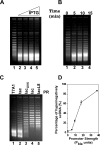Dependence of transcription-coupled DNA supercoiling on promoter strength in Escherichia coli topoisomerase I deficient strains
- PMID: 23201416
- PMCID: PMC5992923
- DOI: 10.1016/j.gene.2012.11.011
Dependence of transcription-coupled DNA supercoiling on promoter strength in Escherichia coli topoisomerase I deficient strains
Abstract
Transcription by RNA polymerase can induce the formation of hypernegatively supercoiled DNA in vitro and in vivo. This phenomenon has been nicely explained by a "twin-supercoiled-domain" model of transcription where a positively supercoiled domain is generated ahead of the RNA polymerase and a negatively supercoiled domain behind it. In Escherichia coli topA strains, DNA gyrase selectively converts the positively supercoiled domain into negative supercoils to produce hypernegatively supercoiled DNA. In this article, in order to examine whether promoter strength affects transcription-coupled DNA supercoiling (TCDS), we developed a two-plasmid system in which a linear, non-supercoiled plasmid was used to express lac repressor constitutively while a circular plasmid was used to gage TCDS in E. coli cells. Using this two-plasmid system, we found that TCDS in topA strains is dependent on promoter strength. We also demonstrated that transcription-coupled hypernegative supercoiling of plasmid DNA did not need the expression of a membrane-insertion protein for strong promoters; however, it might require co-transcriptional synthesis of a polypeptide. Furthermore, we found that for weak promoters the expression of a membrane-insertion tet gene was not sufficient for the production of hypernegatively supercoiled DNA. Our results can be explained by the "twin-supercoiled-domain" model of transcription where the friction force applied to E. coli RNA polymerase plays a critical role in the generation of hypernegatively supercoiled DNA.
Copyright © 2012 Elsevier B.V. All rights reserved.
Figures






Similar articles
-
Transcription-coupled hypernegative supercoiling of plasmid DNA by T7 RNA polymerase in Escherichia coli topoisomerase I-deficient strains.J Mol Biol. 2007 Dec 7;374(4):925-35. doi: 10.1016/j.jmb.2007.10.011. Epub 2007 Oct 11. J Mol Biol. 2007. PMID: 17980389 Free PMC article.
-
Hypernegative supercoiling of the DNA template during transcription elongation in vitro.J Biol Chem. 1994 Jan 21;269(3):2068-74. J Biol Chem. 1994. PMID: 8294458
-
Transient and dynamic DNA supercoiling potently stimulates the leu-500 promoter in Escherichia coli.J Biol Chem. 2017 Sep 1;292(35):14566-14575. doi: 10.1074/jbc.M117.794628. Epub 2017 Jul 10. J Biol Chem. 2017. PMID: 28696257 Free PMC article.
-
Transcription-coupled DNA supercoiling in defined protein systems and in E. coli topA mutant strains.IUBMB Life. 2013 Jul;65(7):615-22. doi: 10.1002/iub.1179. Epub 2013 Jun 12. IUBMB Life. 2013. PMID: 23757201 Free PMC article. Review.
-
[DNA supercoiling and topoisomerases in Escherichia coli].Rev Latinoam Microbiol. 1995 Jul-Sep;37(3):291-304. Rev Latinoam Microbiol. 1995. PMID: 8850348 Review. Spanish.
Cited by
-
DNA supercoiling is a fundamental regulatory principle in the control of bacterial gene expression.Biophys Rev. 2016 Sep;8(3):209-220. doi: 10.1007/s12551-016-0205-y. Epub 2016 Jun 16. Biophys Rev. 2016. PMID: 28510224 Free PMC article. Review.
-
Large-Scale Conformational Transitions in Supercoiled DNA Revealed by Coarse-Grained Simulation.Biophys J. 2016 Oct 4;111(7):1339-1349. doi: 10.1016/j.bpj.2016.07.045. Biophys J. 2016. PMID: 27705758 Free PMC article.
-
Transcription-coupled DNA supercoiling dictates the chromosomal arrangement of bacterial genes.Nucleic Acids Res. 2016 Feb 29;44(4):1514-24. doi: 10.1093/nar/gkw007. Epub 2016 Jan 17. Nucleic Acids Res. 2016. PMID: 26783203 Free PMC article.
-
Manipulation of topoisomerase expression inhibits cell division but not growth and reveals a distinctive promoter structure in Synechocystis.Nucleic Acids Res. 2022 Dec 9;50(22):12790-12808. doi: 10.1093/nar/gkac1132. Nucleic Acids Res. 2022. PMID: 36533444 Free PMC article.
-
DNA supercoiling is a fundamental regulatory principle in the control of bacterial gene expression.Biophys Rev. 2016 Nov;8(Suppl 1):89-100. doi: 10.1007/s12551-016-0238-2. Epub 2016 Nov 14. Biophys Rev. 2016. PMID: 28510216 Free PMC article. Review.
References
-
- Bai L, Santangelo TJ, Wang MD. Single-molecule analysis of RNA polymerase transcription. Annu. Rev. Biophys. Biomol. Struct. 2006;35:343–360. - PubMed
-
- Bates AD, Maxwell A. DNA Topology. 2. Oxford University Press; Oxford, UK: 2005.
-
- Champoux JJ. DNA topoisomerases: structure, function, and mechanism. Annu. Rev. Biochem. 2001;70:369–413. - PubMed
Publication types
MeSH terms
Substances
Grants and funding
LinkOut - more resources
Full Text Sources
Other Literature Sources
Molecular Biology Databases

